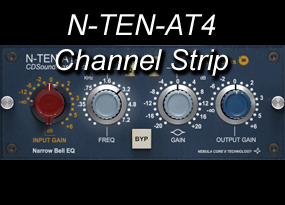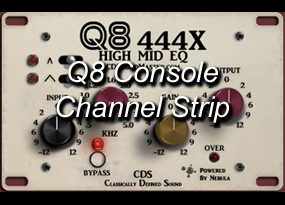Audio Recording with Equalizers – 5 Types of Equalizers – Part Four – The Console Equalizer
The next EQ that I want to describe is the Console EQ. We have a much wider range of diversity in quality and features in the Console EQ than the other categories I describe. Some Console EQ’s are just as high a quality as any Mastering EQ, but there is still something that defines them as a Console EQ. The primary purpose of the Console Equalizer is to provide Frequency adjustments within a single channel of a multi-channel mixing system.
By design, the Console has multiple channels connected side by side, each one carries its own separate audio path. Most Console’s are designed to handle Mono audio channels, but some offer the ability to run stereo pairs for each channel. Console’s come in as few as 4 channels mixed to 1, but typically you will find that a professional Console from any era will be a minimum of 4 channels to two channels. The most common Consoles are 12×2, 16×2, 24×2, 32×2, 48×2, and 64×2. Modular Console designs offer any number of channels above 64 that a facility might need. There are in-line Consoles that can switch the audio path to and from a recording device, and there are others that are twice as wide with just as many “mix” channels as there are recording channels. These designs also include a variable number of “Bus” groups, meaning that channels can be sent to a sub-group before the final stereo output, which may look like a 24x4x2 configuration or similar. There are also fully configured surround processing Consoles that have a multi-channel output in addition to the stereo output, so that a music mix can be automated at the same time as a film-track mix output.
So, where does the Console EQ fit into all of this? The Console EQ is used in the signal path of the individual channels. A device plugs into a single channel, usually signified as a line input, direct inject or direct input, or a microphone input. These three possible levels use their own connection type and their own impedence and draw their unique amount of source current. These devices are sent from the channel input through gain level adjustment and channel fader control. In between the input and output is the EQ circuit. This allows the user to make adjustments to whatever the device is plugged in. If the device has a low rumble, the Console EQ can provide a low cut filter or a high pass filter. The user may want to “print to tape” certain shaped Frequency adjustments that they consider a part of the source sound, boosting or cutting problem areas or enhancing the original signal to suit the needs of the track as it is recorded. The Console EQ can serve a purpose going to a recording device and it can serve a second purpose when mixing. You may wish to prepare the track for using the recording channel the best way, merely cleaning up the signal, and then make some creative mix decisions after the track is recorded. The Console provides something unique from other EQ’s in the fact that it is in the signal path of the original input item as it is being prepared to be recorded. In one sense, the Console EQ is merely in a convenient location to apply the same potential kind of EQ as any other category EQ, but the truth is that the fact that it is within a signal path that is designed to provide amplification to the original source signal means that this can be used as a part of the creative element in recording. You can combine the quality of how clean the input signal is or you can gently saturate the signal to add some effect to the signal as it is recorded and Equalized. The other defining character of the Console EQ is its use after it has been recorded. The EQ can now be patched from the recording device into the same position of the channel that was used to record. The EQ can be used going to the recording device and from the same device once recorded, so it can serve two purposes using a different combination of the same Frequency bands.
The Console EQ is provided for convenience, meaning it is ideal for a wide range of uses and does not need to be patched from an external source for use. It is designed to provide the Frequency adjustments that are most commonly needed. Indeed, a great Console EQ can do everything that most high end EQ’s can do, with the addition of always existing within the context of full gain and volume level control. Typically, the Console Equalizer has fixed Frequency positions, and may have fixed or smooth gain levels. Some Console EQ’s have fewer choices in how high the Frequency range can select, since it may be focused towards individual levels of a voice or instrument, where a Mastering EQ may have unlimited control of highs. But, many Console’s have full shelf control in this area.
Some Console EQ’s are not as high a quality, largely because the quality of the EQ is factored into the overall production cost of the Console. In the late 1980’s the market for budget consoles first began to emerge. There were smaller format and inexpensive Console’s before this point, but there were very few options of any substantial quality below the $1000 mark. The channels were limited, the EQ’s were sub-standard, and the usefulness of the overall signal path was only good enough for demo use. Inexpensive live mixers had very little power and few channels and generally sounded terrible at the sub-$1000 price point. Truly, a decent mixer started at $5000. In the 1990’s, production quality and manufacturing led to some of the first high quality designs for 16 channels of good sounding signal and EQ under $1000. Ten years later, these same features are found in comparable devices at 1/w the price and twice as many channels. The modern audio interface does not come with its own analog EQ signal path, but contains a better average sound quality than devices that used to cost ten times more. The modern concept of the Console is maintained more in the form of the DAW than in analog form, but most professional recording facilities still contain at least one high end room with a real analog Console.
The highest quality Console EQ’s are not only distinguished by their design, cost-per-channel, and efficiency, but are also recognized by the designers themselves. Many Console EQ’s gain a status of their own because they were designed for the mixing process by people who have become famous for their ability to understand the artistic process, the goals of the producers, musicians, and engineers. Because of this, along with their quality, has made many classic Console EQ’s something that many world-class Mastering Facilities use. Whenever this is the case, they are usually found in stereo pairs of original Console channels, and not an entire Console. This is for its use, space, cost, but also because the channels can be used in a direct signal patch and this shortens the signal traditionally feeding the channel to a group or master out, which has more electronics in the chain and can very slightly degrade the signal. Other facilities go so far as to only contain the EQ portion of a channel, making the signal slightly cleaner, but perhaps missing some of the musicality desired from the channel.
The following is a list of EQ’s that CDSoundMaster has created which are excellent for use as Console EQ’s.
The N-TEN-AT4 Console Channel Strip PC VST

The Q8 Console Channel Strip PC VST

Nebula (N3 and N4 Commercial) Program Libraries
https://cdsoundmaster.com/amk-9098-neb/
https://cdsoundmaster.com/ntenneb/
https://cdsoundmaster.com/acc-550a-console-eq-neb/
https://cdsoundmaster.com/115eqneb/
https://cdsoundmaster.com/Nebula-Program-Libraries/Heal-EQ-Neb
